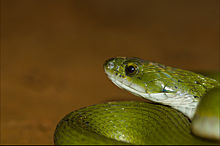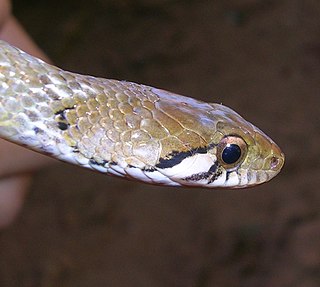
The Nilgiri keelback, also known commonly as Beddome's keelback, is a species of snake found in the Western Ghats in India. The species is named after Richard Henry Beddome, 1830–1911, British army officer and botanist. It was first discovered near the Nilgiris but is now known more widely from the Western Ghats. This snake is terrestrial and feeds on toads.
The Assam keelback, commonly known as Peal's keelback, is a species of snake in the subfamily Natricinae of the family Colubridae. The species is endemic to Northeast India. It has recently been rediscovered after 129 years in Arunachal Pradesh.

The Himalayan keelback is a species of grass snake in the family Colubridae. The species is endemic to South Asia.
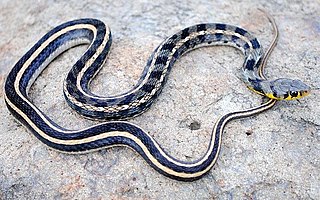
The buff striped keelback is a species of nonvenomous colubrid snake found across Asia. It is the sole species of genus Amphiesma. It is a typically nonaggressive snake that feeds on frogs and toads. It belongs to the subfamily Natricinae, and is closely related to water snakes and grass snakes. It resembles an Asian version of the American garter snake. It is quite a common snake but is rarely seen.
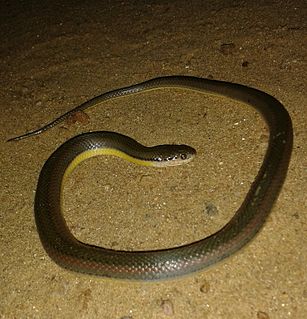
Atretium schistosum, the split keelback or olive keelback wart snake, is a species of snake found in South Asia. It is a common and harmless watersnake.

Boiga forsteni, also known as Forsten's cat snake, is a species of mildly venomous rear-fanged colubrid endemic to South Asia.

Boiga trigonata, commonly known as the Indian gamma snake or common cat snake, is a species of rear-fanged colubrid endemic to South Asia.

The trinket snake is a nonvenomous constrictor species of colubrid snake native to south Central Asia.

Gerarda prevostiana, commonly known as the cat-eyed water snake, Gerard's water snake, or the glossy marsh snake, is a species of snake in the family Homalopsidae. The species is endemic to Asia. It is the only species in the genus Gerarda.

The checkered keelback, also known commonly as the Asiatic water snake, is a common species in the subfamily Natricinae of the family Colubridae. The species is endemic to Asia. It is non-venomous.

Rhabdophis subminiatus, commonly called the red-necked keelback or red-necked keelback snake, is a species of venomous snake in the family Colubridae. The species is endemic to Asia.
St. John's keelback is a species of snake in the subfamily Natricinae of the family Colubridae. The species is endemic to Asia.
Calliophis melanurus, commonly known as the slender coral snake, is a species of venomous elapid snake endemic to the Indian subcontinent. Two subspecies are recognized, including the nominotypical subspecies.

Jerdon's sea snake is a species of venomous sea snake in the subfamily Hydrophiinae.
Hydrophis cantoris, also known commonly as Cantor's narrow-headed sea snake and Cantor's small-headed sea snake, is a species of venomous sea snake in the subfamily Hydrophiinae of the family Elapidae. The species is native to the Indian Ocean and its seas, bays, and gulfs.
Rhinophis blythii, or Blyth's earth snake, is a species of snake in the family Uropeltidae. The species is endemic to the rain forests and grasslands of Sri Lanka.
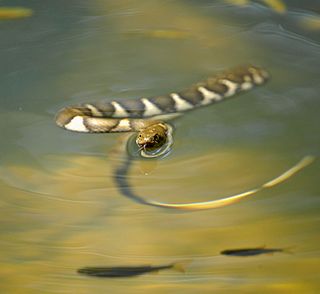
Boulenger's keelback, also known commonly as the Sri Lankan keelback, is a species of water snake in the family Colubridae. The species is endemic to Sri Lanka.
Rhabdophis ceylonensis is endemic to the island of Sri Lanka. The species is commonly known as the Sri Lanka blossom krait, the Sri Lanka keelback, and මල් කරවලා or නිහලුවා (nihaluwa) in Sinhala. It is a moderately venomous snake.
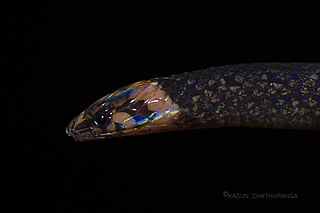
Aspidura guentheri, commonly known as Günther's rough-sided snake, is a species of snake in the family Colubridae. The species is endemic to Sri Lanka. It is the smallest member of the genus Aspidura.
Oligodon calamarius, commonly known as the reed-like kukri or Templeton's kukri snake, is a species of nonvenomous colubrid endemic to Sri Lanka. It is known as කබර දත්-කැටියා in Sinhala.
